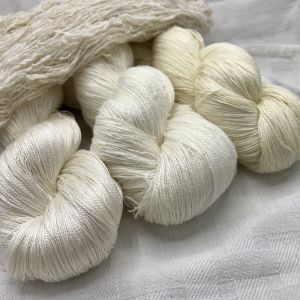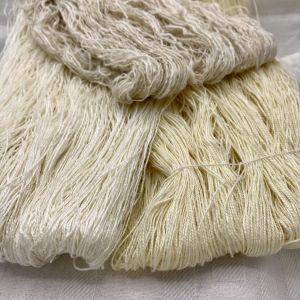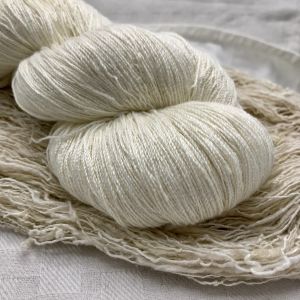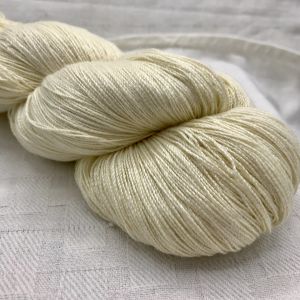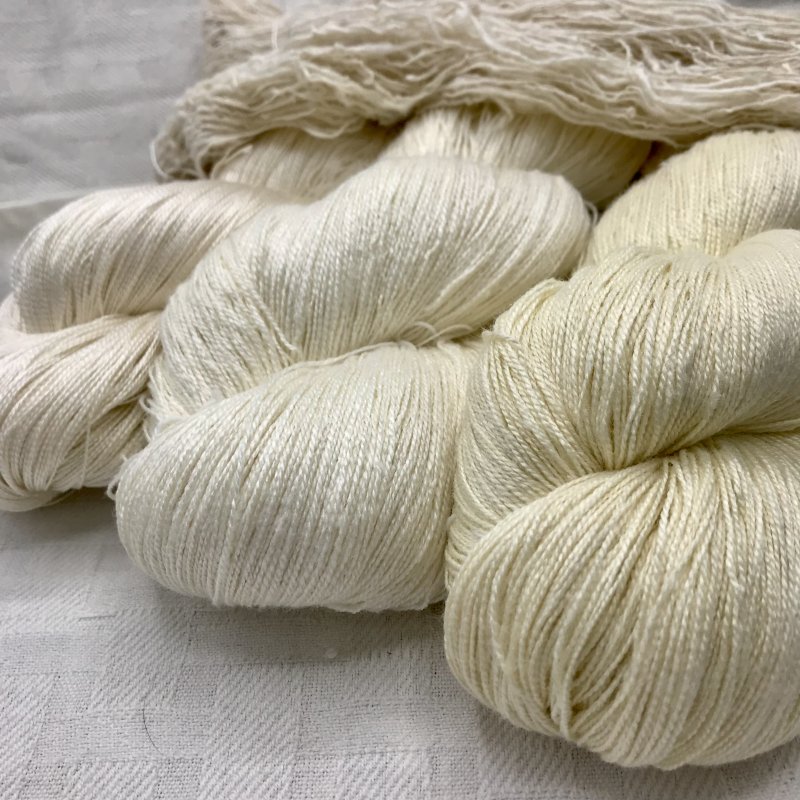
photo above: Shanta (top), L-R Kiku, OmShanti-white, OmShanti-red
see more photos in gallery, below.
We just unpacked TWO new silk yarns from India this week! We are thrilled with both of them and wanted to share it with you right away!
This means we've not done any sample weaving or dyed it yet. But we're taking our best guess at setts, based upon its grist and properties.
Why are we excited?
This is the first time we've had mill-spun Eri Silk yarn. And not only do we have OmShanti-White (white Eri Silk), we also have OmShanti-Red (red Eri Silk).
OmShanti means "eternal peace for all of mankind" (Sanskrit)
Our fabulous silk guy from India believes this is the *first time* Red Eri Silk has been mill spun--and we are thrilled to bring it to you.
We ordered both White Eri Silk and Red Eri Silk in size 20/2, as that's our most popular grist yarn.
Why is Red Eri Cream (and not red)?
Good question! We talked about Red Eri Silk-Natural or Dyed earlier (click to read more).
The short and quick answer is the natural red color is "fugitive" so it doesn't stay during processing.
This means Red Eri Silk becomes a lovely warm cream color.
We think weaving with both OmShanti-White (white Eri Silk) and OmShanti-Red (red Eri Silk) will give a beautiful "white on white" creation. I think our free drafts "Simmering Waves" or "Squares of Lace" would be lovely.
I can just picture using any of the block twills from Chapter 4 in "A Weaver's Book of 8-Shaft Patterns" edited by Carol Stricker.
Or 4-shaft "Goose-Eye Blocks" (p 36) from "A Handweaver's Pattern Book" by Marguerite Porter Davison. Or "Undulating Twill" (p 52) from the same book.
Or, pair Kiku (bombyx 20/2 silk) with OmShanti-Red (red Eri Silk) to add contrasting sheen to your white-on-white weaving.
I was starting down the bunny trail of possibilities with these new yarns--I had to stop and finish writing this! LOL!
ERI SILK:
Eri silk is from the Samia ricini silk worm, which is found in the northeast state of Assam in India.
We call it "wild silk", although it has been domesticated by the tribal villagers for more than a millennium. Its silk is quite different than the silk from Bombyx mori.
The look and feel of Eri Silk is similar to that of cotton. But it has the properties of silk--it keeps the wearer cool in the summer and warm in the winter.
When spinning its cocoon, the Samia ricini silk worm takes breaks, so the fiber is NOT a continuous filament. The silk fibers in the Eri Silk Cocoons are all wound together. When viewed under a microscope, Eri Silk fibers are broader than those of Bombyx mori silk. And broader than cotton fibers.
Depending on how Eri Silk is spun, the yarn can have very different properties...somewhat like wool (soft and a touch sticky) or linen (tight, strong fiber).
COMPARNG OmSHANTI-WHITE & RED:
OmShanti-White feels soft and light and the color is a lovely warm white. This compares quite differently in both color and feel to Shanta, our eri silk that is handspun on a takhli.
OmShanti-Red differs from OmShanti-White in color and also a bit in how it feels. The best word I can find (and it's not that great) is OmShanti-Red feels a bit "denser" than OmShanti-White. But not "heavy."
Our mill-spun Eri Silk follows the same high quality procedures as our bombyx silk yarns--the yarn has been spun from combed fibers and gassed (to make the yarn smooth). Treenway Silks has used the same silk supplier in India for over 20 years and he consistently delivers top quality.
COMPARNG ERI SILK TO BOMBYX SILK:
OmShanti (eri 20/2) and Kiku (bombyx 20/2) are distinctly different yarns. Each yarn shows off the properties of the silk from their different silk worms.
One is not better than the other, they are just different.
OmShanti (eri 20/2) is light and soft, with a matte sheen. A skein of eri feels "fluffier" than Kiku (bombyx 20/2).
OmShanti-White's color (warm white) is slightly whiter than Kiku (bombyx 20/2).
OmShanti-Red is definitely a much creamier color than Kiku (bombyx 20/2).
Kiku is definitely shinier and looks more as one expects spun silk to look. This makes sense to me, as about 90% of silk production worldwide is from Bombyx mori--so that's the silk we know best.
TO ORDER, CLICK ON THE LINKS BELOW:
OmShanti-White
OmShanti-Red
IS ERI SILK "PEACE SILK"? Sorry to tell you, it's not really.
Silk is an eco-friendly product.
If you have past issues of SpinOff magazine, you might want to read Winter 2013, page 42, which has a terrific article by Karen Selk, founder of Treenway Silks. She "myth-busts" many things related to "peace silk". Here's the article's sidebar info:
Ahimsa silk is a patented term referring to an eco-friendly method of manufacturing spun mulberry silk
Eri silk could be peace silk, but most likely it is not, as almost always the pupa is removed for feeding people or other animals.
Don't assume that because tussah, muga and eri silk are wild silks they are peace silks--muga and tussah are also reeled and the eri pupae are used for food--so check your sources.
The only true peace silk is made from cocoons in which the pupa has matured into a moth. Most often this is for breeding purposes, and the quantity of this type of silk is very small.
The caterpillars produced from the eggs resulting from all the matings from unstifled cocoons (200 to 500 eggs per moth) would not have enough food and they would die from starvation and neglect.
Sericulture is a sustainable, renewable, environmentally friendly resource, giving millions of rural people a healthy, family-oriented lifestyle.
Treenway Silks views the entire silk eco-system and what that means (see the last bullet above), so we choose not to seek out and carry "peace silk", the origins of which can seldom be substantiated.


